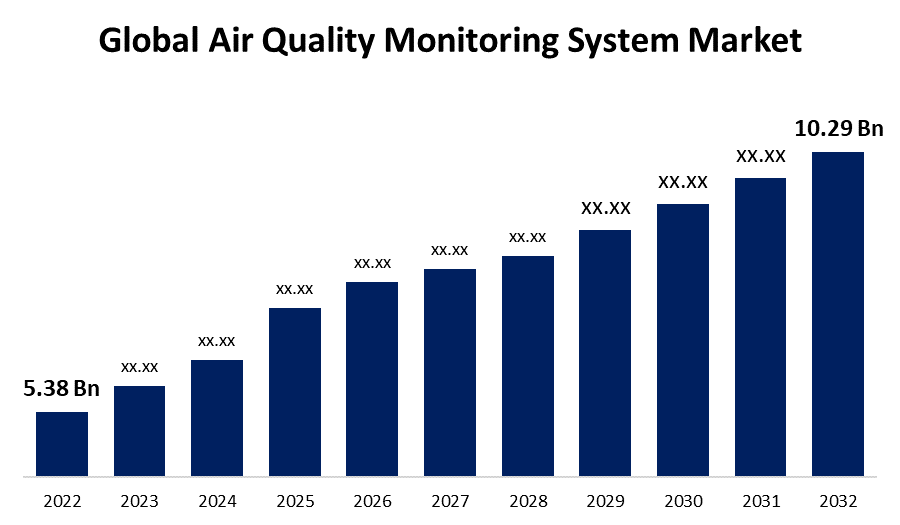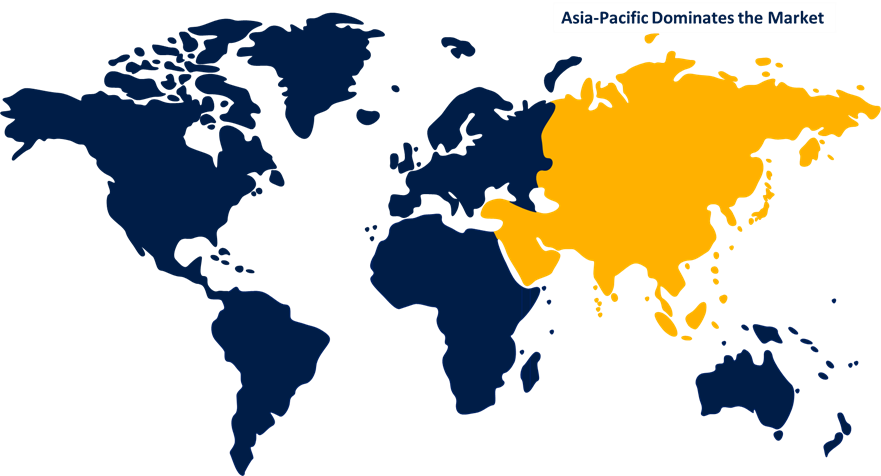Global Air Quality Monitoring System Market Size, Share, and COVID-19 Impact Analysis, By Product (Indoor Monitor and Outdoor Monitor), By Sampling Method (Continuous, Manual, and Intermittent), By End-Use (Residential and Commercial, Power Generation, Petrochemicals, and Others), By Region (North America, Europe, Asia-Pacific, Latin America, Middle East, and Africa), Analysis and Forecast 2023 - 2032 Global Air Quality Monitoring System Market Insights Forecasts to 2032
Industry: Semiconductors & ElectronicsGlobal Air Quality Monitoring System Market Insights Forecasts to 2032
- The Air Quality Monitoring System Market was valued at USD 5.38 Billion in 2022.
- The Market is Growing at a CAGR of 6.7% from 2023 to 2032
- The Global Air Quality Monitoring System Market is expected to reach USD 10.29 Billion by 2032
- Asia-Pacific is expected to Grow the fastest during the forecast period.

Get more details on this report -
The Global Air Quality Monitoring System Market is expected to reach USD 10.29 Billion by 2032, at a CAGR of 6.7% during the forecast period 2023 to 2032.
Market Overview
Air quality monitoring system is a sophisticated network of sensors, instruments, and data processing tools designed to monitor and analyze the quality of the air in a given area. It measures various pollutants such as particulate matter (PM), ozone (O3), nitrogen dioxide (NO2), sulfur dioxide (SO2), and carbon monoxide (CO) in real-time, providing accurate and up-to-date information on air pollution levels. These systems are commonly used by governments, environmental agencies, and industries to assess air quality, develop pollution control strategies, and inform public health policies. The data collected from these systems can help identify pollution hotspots, track changes over time, and raise awareness about the impacts of air pollution on human health and the environment. Overall, Air Quality Monitoring Systems play a crucial role in understanding and mitigating the effects of air pollution on our communities and the planet.
Report Coverage
This research report categorizes the market for air quality monitoring system market based on various segments and regions and forecasts revenue growth and analyzes trends in each submarket. The report analyses the key growth drivers, opportunities, and challenges influencing the air quality monitoring system market. Recent market developments and competitive strategies such as expansion, product launch, and development, partnership, merger, and acquisition have been included to draw the competitive landscape in the market. The report strategically identifies and profiles the key market players and analyses their core competencies in each sub-segments of the air quality monitoring system market.
Global Air Quality Monitoring System Market Report Coverage
| Report Coverage | Details |
|---|---|
| Base Year: | 2022 |
| Market Size in 2022: | USD 5.38 Bn |
| Forecast Period: | 2022 – 2032 |
| Forecast Period CAGR 2022 – 2032 : | 6.7% |
| 022 – 2032 Value Projection: | USD 5.38 Bn |
| Historical Data for: | 2018-2021 |
| No. of Pages: | 200 |
| Tables, Charts & Figures: | 105 |
| Segments covered: | By Product, By Sampling Method, By End-Use, By Region. |
| Companies covered:: | Thermo Fisher Scientific Inc., Teledyne Technologies Inc., Honeywell International Inc., Siemens AG, Aeroqual Ltd., HORIBA Ltd., Testo SE & Co. KGaA, PerkinElmer Inc., TSI Incorporated, 3M Company, Environnement S.A., Vaisala Oyj, Emerson Electric Co., Merck KGaA, California Instruments Corporation. |
| Pitfalls & Challenges: | COVID-19 Empact, Challenge, Future, Growth, & Analysis |
Get more details on this report -
Driving Factors
The air quality monitoring system market is driven by increasing awareness about air pollution's harmful effects, stringent government regulations on emissions, and the need for compliance with environmental standards. Advancements in sensor technology, data analytics, and IoT are enabling more accurate and real-time monitoring of air quality. The rising prevalence of respiratory diseases and other health concerns related to air pollution is creating demand for air quality monitoring systems for public health and safety. Additionally, growing investments in smart city initiatives, sustainable development goals, and environmental sustainability are further driving the adoption of air quality monitoring systems in various sectors, including industrial, residential, commercial, and transportation.
Restraining Factors
The air quality monitoring system market faces several restraints. Firstly, the high cost of equipment, installation, and maintenance can limit the affordability and accessibility of air quality monitoring systems, especially for small-scale or resource-constrained settings. Secondly, challenges related to data accuracy, consistency, and interoperability due to the lack of standardized monitoring methodologies and data reporting formats can impact the reliability and comparability of air quality data. Thirdly, regulatory complexities, including varying emission standards and compliance requirements across different regions or countries, can create barriers to market entry and expansion.
Market Segmentation
- In 2022, the indoor monitor segment accounted for around 65.1% market share
On the basis of the product type, the global air quality monitoring system market is segmented into the indoor monitor and outdoor monitor. The indoor monitor segment is dominating the market with the largest market share in 2022, due to the increasing awareness about the importance of indoor air quality. With people spending a significant amount of time indoors, particularly in residential and commercial buildings, the need for monitoring and improving indoor air quality has gained prominence. The indoor monitor category includes devices that measure and analyze indoor air pollutants such as volatile organic compounds (VOCs), particulate matter (PM), and carbon dioxide (CO2). The growing concerns about the health risks associated with poor indoor air quality and the adoption of healthier indoor living and working environments have driven the demand for indoor air quality monitoring systems, making the indoor monitor category a dominant segment in the market.
- In 2022, the continuous segment dominated the market with more than 35.6% market share
Based on the sampling method, the global air quality monitoring system market is segmented into continuous, manual, and intermittent. Out of this, the continuous category dominated the market with the largest market share in 2022, due to its ability to provide real-time and continuous monitoring of air quality parameters. This category offers timely and accurate data updates, allowing for immediate analysis and action to mitigate health risks and comply with environmental regulations. With increasing concerns about air pollution and its impacts on human health and the environment, there is a growing demand for continuous monitoring systems that can provide ongoing and up-to-date information. As a result, the continuous category has gained traction in the market as it offers benefits such as improved decision-making capabilities and early warning systems.
Regional Segment Analysis of the Air Quality Monitoring System Market
- North America (U.S., Canada, Mexico)
- Europe (Germany, France, U.K., Italy, Spain, Rest of Europe)
- Asia-Pacific (China, Japan, India, Rest of APAC)
- South America (Brazil and the Rest of South America)
- The Middle East and Africa (UAE, South Africa, Rest of MEA)
Asia-Pacific dominated the market more than 32.5% revenue share in 2022.

Get more details on this report -
Based on region, the Asia-Pacific region is a dominant market in the air quality monitoring system industry. Rapid industrialization, urbanization, and increasing vehicular emissions in countries like China, India, and Japan have led to heightened concerns about air pollution and its adverse impacts on public health and the environment. As a result, there has been a growing demand for effective air quality monitoring systems to measure, analyze, and manage air pollution levels. Additionally, stringent government regulations and initiatives to curb air pollution, along with rising awareness about the need for sustainable development, have further fueled the adoption of air quality monitoring systems in the Asia-Pacific region, making it a key market for the industry's growth.
Competitive Analysis:
The report offers the appropriate analysis of the key organizations/companies involved within the global air quality monitoring system market along with a comparative evaluation primarily based on their product offering, business overviews, geographic presence, enterprise strategies, segment market share, and SWOT analysis. The report also provides an elaborative analysis focusing on the current news and developments of the companies, which includes product development, innovations, joint ventures, partnerships, mergers & acquisitions, strategic alliances, and others. This allows for the evaluation of the overall competition within the market.
List of Companies:
- Thermo Fisher Scientific Inc.
- Teledyne Technologies Inc.
- Honeywell International Inc.
- Siemens AG
- Aeroqual Ltd.
- HORIBA Ltd.
- Testo SE & Co. KGaA
- PerkinElmer Inc.
- TSI Incorporated
- 3M Company
- Environnement S.A.
- Vaisala Oyj
- Emerson Electric Co.
- Merck KGaA
- California Instruments Corporation
Key Target Audience
- Market Players
- Investors
- End-Users
- Government Authorities
- Consulting and Research Firm
- Venture Capitalists
- Value-Added Resellers (VARs)
Recent Developments
- In February 2022, Hawadawa, a German manufacturer of air quality monitoring equipment, has formed a strategic partnership with Thies Clima to launch a one-stop solution that can determine the relationship between air quality and weather conditions for a better understanding of the air quality status and provide the best data revelations on IT tools such as dashboards. This collaboration has broadened the company's product offering as well as its client base.
Market Segment
This study forecasts revenue at global, regional, and country levels from 2019 to 2032. Spherical Insights has segmented the global air quality monitoring system market based on the below-mentioned segments:
Air Quality Monitoring System Market, By Product
- Indoor Monitor
- Outdoor Monitor
Air Quality Monitoring System Market, By Sampling Method
- Continuous
- Manual
- Intermittent
Air Quality Monitoring System Market, By End-Use
- Residential and Commercial
- Power Generation
- Petrochemicals
- Others
Air Quality Monitoring System Market, Regional Analysis
- North America
- US
- Canada
- Mexico
- Europe
- Germany
- Uk
- France
- Italy
- Spain
- Russia
- Rest of Europe
- Asia Pacific
- China
- Japan
- India
- South Korea
- Australia
- Rest of Asia Pacific
- South America
- Brazil
- Argentina
- Rest of South America
- Middle East & Africa
- UAE
- Saudi Arabia
- Qatar
- South Africa
- Rest of Middle East & Africa.
Need help to buy this report?